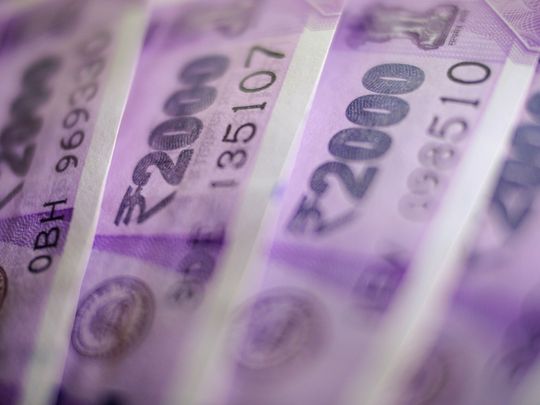
Dubai: As expected, India's central bank has moved in with a 0.50 per cent hike in inter-bank rates, in a bid to counter inflationary pressures on the economy.
The Indian rupee for now is holding steady at 22.21 levels to the dirham, but it remains to be seen whether the RBI move will help stabilise the heavy decline in the currency's value in recent days.
"The INR has been in the all-time low range of 22.20-22.29 in recent days, and the initial reaction would be for the currency to stabilise at the 22.20 mark," said an FX analyst. "Whether this will continue is an unknown, because we are still seeing the dollar gaining. Whatever be the case, UAE's Indian expats are still getting highly favourable exchange rate."
The current exchange rate on the INR-Dh is 22.10. In the recent past, the all-time low had been 22.30 (or 81.95 in INR-dollar terms). "Today, against AED, we expect the range for the INR would be 22.14-22.29," said a top official at LuLu Exchange. "In the coming week, 82.20 remains a crucial resistance level for INR as RBI may also look to limit any sharp INR fall against USD and 80.20 may act as support for INR.
"In dirham terms, we expect the range for the INR would be 21.90-22.38."
Since May, the RBI has raised the base rate from 4 per cent to 5.90 per cent now, with inflation at or above the 7 per cent mark. The initial reaction from the Indian stock markets remain on the positive side, with the Sensex up nearly 200 points.

The silver lining is that only when the home loan interest rates breach the 9.5% mark will India's housing sales see a ‘high impact’. If (mortgage) rates remain between 8.5-9%, the impact is expected to be moderate
Loans will price in new rates
While Indian expats will still have the INR at over 22, for resident Indians, the latest rate hike will add to their cost of servicing loans. "Home loans will get dearer soon - this could impact residential sales to some extent during the upcoming festive quarter, particularly in the affordable and mid-range housing segments," said Anuj Puri, Chairman of Anarock, the consultancy.
"The hike in home loan rates will be in addition to the other increasing costs such as inflationary trends of construction input costs. With the overall acquisition cost increasing further, developers will have to seriously consider doling out targeted offers and discounts to boost sales during the critical festive quarter."
The INR dropped below 21 (on May 9) and 22 levels this year, with the 22 break happening September 23. To break two new lows in the same year is quite unprecedented for the INR - but the times are such
Watch the dollar
The dollar has shed some of its strength, but still does carry a heavy punch. Then there is the continuing uncertainty over what's next for global markets. All of which would decide what happens next with the rupee. "With the global scenario still being very uncertain, it will take a few quarters for the INR to stabilize," said Krishnan Ramachandran, CEO of Barjeel Geojit Financial Services. "There are good possibilities for the INR to depreciate further in the near term."












